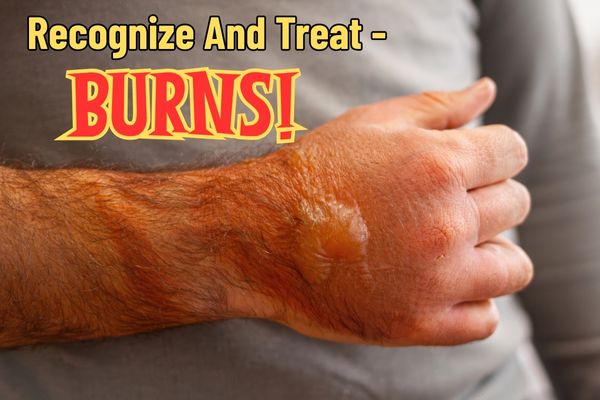During emergencies, when professional medical care is often unavailable or delayed, burns pose one of the most serious survival threats.
Whether dealing with power grid failures, natural disasters, or extended periods of self-reliance, the necessities of off-grid living dramatically elevates burn risks. Understanding how to recognize, treat, and prevent burns could help you save a life.
Why Burns Become More Dangerous During Emergencies
Context changes how we interact with fire and heat. When the electrical grid fails, we rely on candles, oil lamps, and wood-burning stoves for warmth and light. Propane camping stoves replace electric ranges, and improvised heating methods fill gaps left by failed HVAC systems. These new tools and desperate circumstances create a host of fire risks.
How emergencies increase the risk of burns: In the aftermath of Hurricane Sandy, emergency rooms reported significant increases in burn injuries as people used generators indoors, improvised heating solutions, and unfamiliar cooking methods.
The psychological stress of emergencies also impairs judgment and increases accident risk. Fatigue, anxiety, and unfamiliarity with backup systems all contribute to mistakes that can result in severe burns. Children face particular risks as normal safety routines break down and dangerous items become more necessary.
Understanding Burn Severity: The Three Degrees
Medical professionals classify burns into three primary categories based on depth and tissue damage.
First-Degree Burns: Surface Level Injuries
First-degree burns affect the skin’s outermost layer. These injuries result from brief contact with hot objects, scalds, or sun exposure. Recognition involves several key characteristics:
Pain levels with first-degree burns usually remain manageable and tend to decrease within 24-48 hours. The skin may peel several days after the injury as it heals, similar to sunburn recovery. When properlyt cared for, these burns typically heal completely within 3-7 days without scarring.
First Degree Burn Treatment
Immediate Care:
<1> Remove the heat source and cool the burn with cool (not ice-cold) running water for 10-15 minutes
<2> Gently pat the area dry with a clean towel
<3> Apply a thin layer of aloe vera gel or a burn-specific topical treatment
<4> Cover with a loose, sterile bandage if clothing might rub against the area
<5> Take over-the-counter pain relievers like ibuprofen or acetaminophen as directed
Ongoing Care:
:: Keep the area clean and moisturized
:: Avoid breaking any peeling skin
:: Stay hydrated to support healing
:: Monitor for signs of infection
Second-Degree Burns: Deeper Tissue Damage
Second-degree burns penetrate through the epidermis into the dermis, causing more significant injuries. Superficial second-degree burns create the characteristic fluid-filled blisters that most people associate with serious burns. The surrounding skin appears red and mottled, often with a wet or weeping appearance. Deep second-degree burns present more serious symptoms. While blisters may still form, the skin often appears waxy, white, or even charred in patches.
Second Degree Burn Treatment
Immediate Care:
<1> Cool the burn with cool running water for 15-20 minutes
<2> Do NOT break blisters intentionally
<3> Gently clean around the burn with mild soap, avoiding the burned area itself
<4> Apply a thin layer of antibiotic ointment if available
<5> Cover with sterile, non-adherent gauze and secure with medical tape
<6> Elevate the burned area if possible to reduce swelling
Ongoing Care:
:: Change dressings daily or when they become wet/dirty
:: Watch for signs of infection: increased redness, pus, red streaking, fever
:: Keep blisters intact as they provide natural protection
:: Seek medical attention for burns larger than 2-3 inches or showing signs of infection
Third-Degree Burns: Full-Thickness Destruction
Third-degree burns destroy all skin layers and enter fat, muscle, and bone. These injuries are true medical emergencies that typically require surgical intervention for proper healing.
The appearance of third-degree burns often surprises people because they don’t always look like the worst injuries. The skin may appear white, brown, black, or leathery in texture. Paradoxically, these burns often cause less pain than second-degree burns because nerve endings have been destroyed. However, the surrounding area with lesser burns will cause significant pain.
The burned area feels firm and inflexible rather than soft and pliable like normal skin. No blanching occurs when pressed because blood circulation has been destroyed. Third-degree burns never heal properly without surgical intervention. They require skin grafts and extensive medical treatment. In emergency situations without access to proper medical care, these injuries often prove fatal due to infection, fluid loss, and shock.
Third Degree Burn Treatment
Third degree burns require immediate emergency medical attention. However, in situations where professional help is not immediately available:
Emergency Field Care:
<1> Call for emergency medical help immediately if possible
<2> Do NOT use water on large third degree burns (can cause hypothermia)
<3> Cover the burn with a clean, dry cloth or sterile bandage
<4> Do NOT apply ointments, ice, or home remedies
<5> Remove jewelry or tight clothing near the burn before swelling occurs
<6> Monitor for shock and treat accordingly
<7> Keep the person warm and lying down
<8> If fingers or toes are burned, place gauze between them
Critical Warning: Third degree burns covering more than 10% of body surface area or affecting the face, hands, feet, genitals, or major joints are life-threatening emergencies.
Consequences of Untreated Burns
Failing to properly treat burns, especially second and third degree burns, can lead to serious complications that may become life-threatening in emergency situations where medical care is limited.
Infection Complications
Burns compromise the skin’s protective barrier, creating entry points for bacteria. Untreated burn infections can progress rapidly:
Local Infection: Begins with increased redness, warmth, swelling, and pus formation. The burn may develop a foul odor and show red streaking extending from the wound.
Cellulitis: Bacterial infection spreads into deeper skin layers, causing widespread redness, warmth, and systemic symptoms like fever and chills.
Sepsis: Life-threatening condition where infection enters the bloodstream. Symptoms include high fever, rapid heart rate, confusion, and potential organ failure. Without immediate medical intervention, sepsis can be fatal.
Keloid Formation: Some individuals develop raised, thick scars that extend beyond the original burn area. These can be painful, itchy, and cosmetically disfiguring.
Functional Impairment: Severe scarring can limit the use of hands, restrict joint movement, or affect facial expressions and speech if burns occur on the face or neck.
Hypothermia Risk
Extensive burns disrupt the body’s ability to regulate temperature. Damaged skin cannot effectively conserve heat, leading to dangerous drops in core body temperature even in moderate environments.
Essential Treatment Supplies
Building a comprehensive burn treatment kit is crucial for emergency preparedness. Here’s what you should have on hand:
Basic Supplies:
:: Sterile gauze pads (various sizes: 2×2, 4×4 inches)
:: Non-adherent dressings (Telfa pads)
:: Medical tape
:: Elastic bandages
:: Sterile saline solution for cleaning
:: Antibiotic ointment (bacitracin or triple antibiotic)
:: Aloe vera gel (pure, without additives)
:: Pain relievers (ibuprofen, acetaminophen)
:: Burn gel or hydrogel dressings
:: Scissors for cutting tape and gauze
:: Disposable gloves
:: Instant cold compresses
Advanced Supplies:
:: Silver sulfadiazine cream (prescription burn treatment)
:: Hydrocolloid dressings for smaller burns
:: Medical honey (for its antimicrobial properties)
:: Oral rehydration salts
:: Thermometer
:: Emergency blanket
:: Injectable pain medication (if trained and legally able to possess)
Fluid and Electrolyte Imbalances
Large burns cause significant fluid loss through damaged skin.
Without proper fluid replacement:
Dehydration: Can lead to kidney failure, shock, and death.
Electrolyte Imbalances: Can affect heart rhythm and muscle function.
Burn Shock: A form of hypovolemic shock specific to large burns
Hypothermia Risk
Extensive burns disrupt the body’s ability to regulate temperature. Damaged skin cannot conserve heat, leading to dangerous drops in core body temperature even in moderate environments.
When to Seek Professional Medical Care
Even with good field treatment capabilities, certain burn situations require professional medical intervention:
Immediate Emergency Care Needed:
:: Any third degree burn
:: Burns covering more than 10% of body surface area
:: Burns to the face, hands, feet, genitals, or major joints
:: Electrical or chemical burns
:: Signs of infection
:: Burns in elderly people, young children, or those with compromised immune systems
Evacuation Considerations: In remote or emergency situations, plan evacuation routes and communication methods for serious burn injuries. Know the locations of the nearest medical facilities and have emergency contact information readily available.
Special Burn Considerations and Advanced Recovery
Certain factors significantly impact burn healing and treatment effectiveness. Age plays a crucial role. Children under 5 and adults over 65 heal slower, and face higher complication risks. Nutritional status dramatically affects recovery; burns increase protein and calorie requirements by up to 50%, making adequate nutrition essential for healing.
Smoking impairs circulation and oxygen delivery to healing tissues, potentially doubling recovery time. Pre-existing conditions like diabetes and autoimmune disorders complicate healing and increase infection risk. Environmental factors also matter. High humidity promotes bacterial growth in dressings, while extremely dry conditions cause additional skin cracking around burn sites.
Building Burn Treatment Competency
Developing burn treatment skills before emergencies occur is crucial. Consider taking wilderness first aid courses, practicing bandaging techniques, and familiarizing yourself with your burn treatment supplies. Understanding the progression of burn healing helps you monitor for complications and make informed decisions about when to seek additional help.
Remember that while this guide provides essential information for emergency burn treatment, it cannot replace professional medical judgment. In any serious burn situation, seek professional medical care as soon as possible while providing appropriate field treatment to stabilize the injury and prevent complications.
When confronted with a burn injury, quick and appropriate treatment is key. Also, vigilant monitoring of burns for complications is vital. By understanding these principles and maintaining proper supplies, you’ll be more prepared to handle injuries effectively, whether at home or in challenging emergencies.




